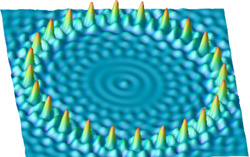Roundup at the Optical Corral

If you want to keep a horse confined, put it in a corral. Now, it appears the same thing can be done with light. In the 21 May PRL, a team shows how an arrangement of nanoscale pillars forms an “optical quantum corral” that can force light waves into a predictable set of quantum states. If the theory is confirmed by experiments, it will help researchers interpret images from scanning probe microscopes and may also lead to brighter fluorescent probes of biomolecules.
Even when a surface seems to reflect all the light shining on it, localized electromagnetic fields extend a short distance beyond the reflecting boundary. In a related effect, non-propagating fields also emanate a very small distance above almost any material surface when light hits it. The unobtrusive fields rarely cause any trouble, but they have recently become a problem for physicists who look too close. A scanning near-field optical microscope (SNOM) measures atomic-scale undulations on a surface by picking up reflected light waves. When the probe tip gets too close, the fields produced at the material’s surface distort the image. “It is an ongoing problem that a SNOM can’t measure the topography directly,” says William Barnes of the University of Exeter in the UK.
This interference motivated Christian Girard of the French National Center for Scientific Research (CNRS) in Toulouse and his colleagues at the Burgundy University in Dijon to try to predict the fields arising from specific surface configurations. The team calculated the local density of states (LDOS)–related to the strength of electromagnetic fields that can exist at a given location–for increasingly symmetric arrangements of 100-nm-tall posts. 24 posts arranged in a 3.6-µm-diameter circle generate an LDOS pattern that looks similar to IBM’s famous ”quantum corrals”made of single atoms placed in a circle on a metal surface. Within an atomic corral, electron waves of specific frequencies form visible ripples in the scanning tunneling microscope images; likewise, only certain colors of light are optimally sustained inside the optical corrals, according to the calculations. The technique can be used by anyone to calculate the LDOS for any arbitrary geometry, says Girard, which may help clarify the interpretation of SNOM images.
Although simply knowing the LDOS won’t remove all of the uncertainty in a SNOM image, says Barnes, the new information could greatly improve topographical maps when it is combined with information from the SNOM and a scanning tunneling microscope. The new technique also has another potential application. The LDOS gives the probability that a fluorescing molecule will radiate a photon of a given wavelength. Placing a fluorescent molecule, like those used to follow the internal motions of proteins, inside the circle of posts could enhance the fluorescent signal by forcing the molecule to radiate at a wavelength favored by the arrangement of posts. “This is a very exciting new perspective for biosensing,” says Olivier J. F. Martin of the Swiss Federal Institute of Technology in Zurich.
But first, Girard’s team has to prove that their theory predicts the LDOS above a real surface. “We have three different labs working on this now,” says Girard. And he says that at least one of the labs will soon formally announce that they have produced optical quantum corrals that match the predictions.
–Mark Sincell
Mark Sincell is a freelance science writer based in Houston, TX.
More Information
experimental observation of an optical corral: C. Chicanne et al., “Imaging the Local Density of States of Optical Corrals,” Phys. Rev. Lett. 88, 097402 (2002)


